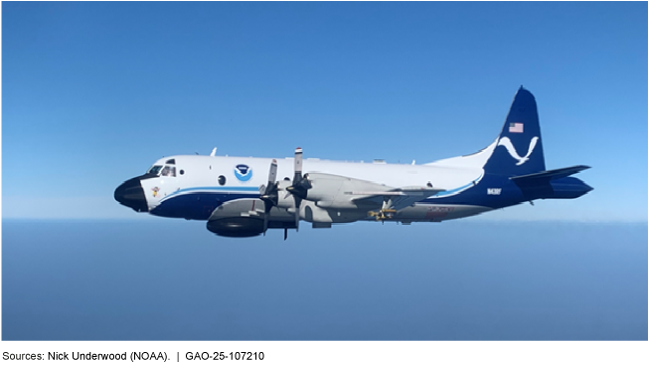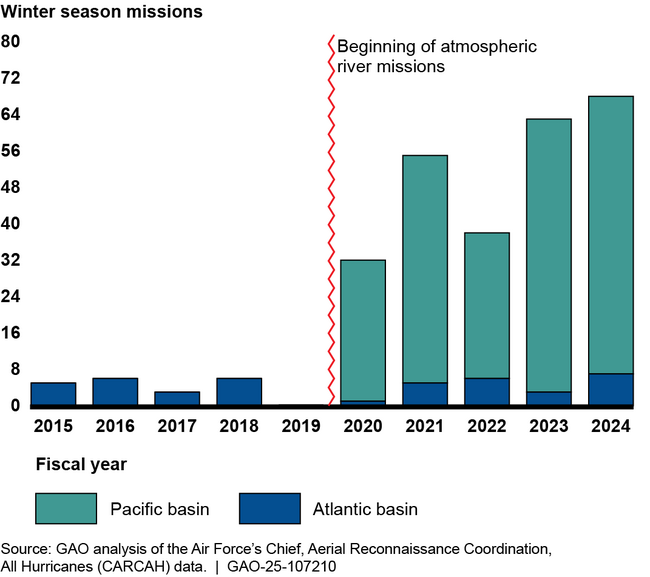Hurricane Hunter Aircraft: NOAA and Air Force Should Take Steps to Meet Growing Demand for Reconnaissance Missions
Fast Facts
The National Oceanic and Atmospheric Administration and the Air Force fly Hurricane Hunter aircraft into tropical cyclones and winter storms to collect data for weather forecasts.
Demand for their work has grown since 2014 as tropical cyclone activity increased and as they were tapped to begin collecting data on Pacific storms that can cause West Coast floods.
The Hurricane Hunters haven't always met rising demand and haven't systematically tracked the reasons why.
But officials told us about:
Aircraft maintenance issues and staff shortages
A lack of coordination on aircraft upgrades and replacement
Our recommendations address this, and more.
NOAA operates two Lockheed WP-3D Orion aircraft as Hurricane Hunters

Highlights
Why This Matters
The National Oceanic and Atmospheric Administration (NOAA) and the Air Force fly aircraft—known as Hurricane Hunters—into tropical cyclones and winter storms. Equipment on these aircraft collects critical data to help forecast a storm’s track and intensity.
Information from these aerial reconnaissance missions helps with evacuation efforts and storm preparations to protect life and property.
GAO Key Takeaways
Hurricane Hunter operations have increased since 2014, especially winter season missions, because of new responsibilities and greater demand for data. This has strained NOAA’s and the Air Force’s ability to meet their Hurricane Hunter responsibilities.
NOAA and Air Force officials said that limited aircraft availability and staffing shortages have contributed to Hurricane Hunters missing mission requirements—the key tasks of a mission. For example, they said maintenance issues prevented NOAA’s sole high-altitude jet from flying two Hurricane Helene missions in 2024. Since 2014, a growing number of mission requirements have been missed. However, NOAA and the Air Force have not systematically tracked the reasons for this. They also have not comprehensively assessed their Hurricane Hunter workforces to see if changes to staffing levels or workforce structure are needed.
NOAA plans to acquire six aircraft to replace its three aging planes, and the Air Force has identified needed technology upgrades for its aircraft. However, NOAA and Air Force senior leaders do not have a mechanism to regularly communicate with each other about their plans and resources. This has hampered the agencies’ ability to ensure that their decisions about investments in the Hurricane Hunters are aligned.
Winter Season Reconnaissance Missions Have Increased

Note: Atmospheric rivers are regions in the atmosphere that transport water vapor from the tropics to higher latitudes, leading to extreme precipitation and flooding on the U.S. West Coast. This figure includes reconnaissance missions NOAA and the Air Force flew but does not include other types of missions such as research missions focused on atmospheric rivers.
How GAO Did This Study
We analyzed data and documents and interviewed officials from NOAA and the Air Force. We compared agency efforts against our key practices for evidence-based policymaking, among other things.
Recommendations
We are making eight recommendations, including that NOAA and Air Force track data on why mission requirements are missed, assess their Hurricane Hunter workforces, and establish a mechanism for senior leaders to regularly communicate. The agencies agreed with our recommendations.
Recommendations for Executive Action
| Agency Affected | Recommendation | Status |
|---|---|---|
| Department of the Air Force | The Commander of the Air Force Reserve Command should, in coordination with the Administrator of NOAA, develop and implement a process to systematically track data on the reasons Hurricane Hunter mission requirements are missed. (Recommendation 1) |
The Department of Defense agreed with this recommendation and said that it plans to work with the Administrator of NOAA to develop a process to track the reasons mission requirements are missed. GAO will continue to monitor the actions Defense takes in response to this recommendation.
|
| National Oceanic and Atmospheric Administration | The Administrator of NOAA should, in coordination with the Commander of the Air Force Reserve Command, develop and implement a process to systematically track data on the reasons Hurricane Hunter mission requirements are missed. (Recommendation 2) |
NOAA agreed with this recommendation and said that it plans to collaborate with the Commander of the Air Force Reserve command on a process that tracks coordinated mission readiness. GAO will continue to monitor the actions NOAA takes in response to this recommendation.
|
| Department of the Air Force | The Commander of the Air Force Reserve Command should perform a comprehensive assessment of its Hurricane Hunter workforce, including examining staffing levels and workforce structure, to inform future workforce planning. (Recommendation 3) |
The Department of Defense agreed with this recommendation and said that it plans to examine staffing levels and workforce structures to develop a plan to meet current and future mission needs. GAO will continue to monitor the actions Defense takes in response to this recommendation.
|
| National Oceanic and Atmospheric Administration | The Administrator of NOAA should perform a comprehensive assessment of its Hurricane Hunter workforce, including examining staffing levels and workforce structure, to inform future workforce planning. (Recommendation 4) |
NOAA agreed with this recommendation. GAO will continue to monitor the actions NOAA takes in response to the recommendation.
|
| Department of Commerce | The Secretary of Commerce should ensure that NOAA's funding needs for Hurricane Hunter aircraft acquisitions are regularly communicated to relevant stakeholders, including Congress, such as by including information on these needs in its annual budget requests. (Recommendation 5) |
NOAA agreed with this recommendation and said that it plans to incorporate information on funding needs for Hurricane Hunter aircraft acquisitions into its annual budget requests and other communications. GAO will continue to monitor the actions NOAA takes in response to this recommendation.
|
| Department of the Air Force | The Commander of the Air Force Reserve Command should assess whether Air Force processes create barriers to upgrading Hurricane Hunter aircraft capabilities and define strategies to mitigate any identified barriers, as appropriate. (Recommendation 6) |
The Department of Defense agreed with this recommendation and said that it plans to identify and support changes to improve its processes. GAO will continue to monitor the actions Defense takes in response to this recommendation.
|
| National Oceanic and Atmospheric Administration | The Administrator of NOAA should, in coordination with the Commander of the Air Force Reserve Command, establish a mechanism for their senior leaders to regularly communicate and share information about Hurricane Hunter plans and resources. (Recommendation 7) |
NOAA agreed with this recommendation and said that it recognizes the importance of senior-level interagency communication for the success of the agencies' shared Hurricane Hunter mission. GAO will continue to monitor the actions NOAA takes in response to this recommendation.
|
| Department of the Air Force | The Commander of the Air Force Reserve Command should, in coordination with the Administrator of NOAA, establish a mechanism for their senior leaders to regularly communicate and share information about Hurricane Hunter plans and resources. (Recommendation 8) |
The Department of Defense agreed with this recommendation and said that it recognizes the importance of communicating with its interagency partners at the senior leader level for the success of the shared Hurricane Hunter mission. GAO will continue to monitor the actions Defense takes in response to this recommendation.
|
